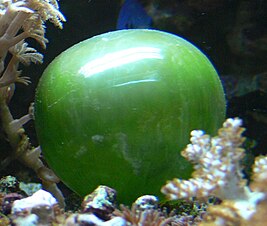Unicellular organism
From Wikipedia, the free encyclopedia
"Single-celled" redirects here. For prison cell assignment, see Single-celling.

Valonia ventricosa, a species of algae with a diameter that ranges typically from 1 to 4 centimetres (0.39 to 1.57 in) is among the largest unicellular species
Prokaryotes, most Protista, and some fungi, are unicellular. Although some of these organisms live in colonies, they are still unicellular. These organisms live together, and each cell in the colony is the same. However, each individual cell must carry out all life processes to survive. In contrast, even the simplest multicellular organisms have cells that depend on each other to survive.
Some organisms are partially uni- and multicellular, like Dictyostelium discoideum. The other can be unicellular and multinucleate, like Myxogastria and Plasmodium.
Candidatus Magnetoglobus multicellularis, related to Deltaproteobacteria, is a multicellular prokaryote. It is neither unicellular, nor a colony.
Most unicellular organisms are of microscopic size and are thus classified as microorganisms. However, some unicellular protists and bacteria are macroscopic and visible to the naked eye.[3] Examples include:
- Xenophyophores, protozoans of the phylum Foraminifera, are the largest examples known, with Syringammina fragilissima achieving a diameter of up to 20 cm (7.9 in)[4]
- Nummulite, foraminiferans
- Valonia ventricosa, an alga of the class Chlorophyceae, can reach a diameter of 1 to 4 cm (0.4 to 2 in)[5][6]
- Acetabularia, algae
- Caulerpa, algae[7]
- Gromia sphaerica, amoeba
- Thiomargarita namibiensis is the largest bacterium, reaching a diameter of up to 0.75 mm
- Epulopiscium fishelsoni, a bacterium
See also
References
- Monad, Biology online, retrieved 2011-06-30
- An Introduction to Cells, ThinkQuest, retrieved 2013-05-30
- Max Planck Society Research News Release Accessed 21 May 2009
- Researchers Identify Mysterious Life Forms in the Extreme Deep Sea. Accessed 2011-10-24.
- Bauer, Becky (October 2008). "Gazing Balls in the Sea". All at Sea. Retrieved 27 August 2010.
- John Wesley Tunnell, Ernesto A. Chávez, Kim Withers (2007). Coral reefs of the southern Gulf of Mexico. Texas A&M University Press. p. 91. ISBN 1-58544-617-3.
- "What is the Largest Biological Cell? (with pictures)". Wisegeek.com. 2014-02-23. Retrieved 2014-03-01.[unreliable source?]
| This biology article is a stub. You can help Wikipedia by expanding it. |


Post a Comment